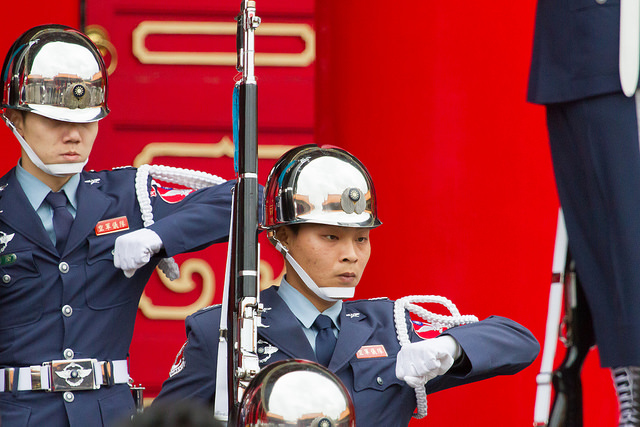 Taiwanese defence planners face a simple—though unenviable—task when crafting the country’s defence policy and military strategy. Taiwan’s only potential enemy is the People’s Republic of China, which is rapidly modernising the PLA. In the face of that build-up, Taiwan’s major political parties and defence policy documents reflect turning to the Taiwanese domestic defence industry to address the country’s defence needs.
Taiwanese defence planners face a simple—though unenviable—task when crafting the country’s defence policy and military strategy. Taiwan’s only potential enemy is the People’s Republic of China, which is rapidly modernising the PLA. In the face of that build-up, Taiwan’s major political parties and defence policy documents reflect turning to the Taiwanese domestic defence industry to address the country’s defence needs.
Taiwan’s military transformation has been more gradual than that of the much larger PLA. It appears to be trying to keep up with China rather than to maintain a capability edge. Taiwan’s military strategy has shifted from combined offence and defence in 1980s, to ‘defensive defence’ in 1990s, to active defence in 2000s, and back to a more defensive posture since 2008.
Behind those doctrinal changes is Taiwan’s continuous adaptation to changing conditions and a concentration on advanced weapon systems. For example, Taiwan’s greater emphasis on active defence after 2000 reflected the development and procurement of weapon systems able to engage PLA forces or even target cities deep inside China with previously unseen precision. This led to policymakers to contemplate pre-emptive strike as an alternative to absorbing the enemy’s first attack. The return to a ‘defensive defence’ posture (aka Hard ROC) in recent years is a reflection of a softer approach towards China by Taiwan’s current government, and the realisation that pre-emptive attack is politically problematic. Instead of associating capabilities with pre-emption, recent Taiwanese policy documents have embedded them in Taiwan’s drive for asymmetry and innovation in its defence posture.
Taiwan’s acquisition options are limited for two main reasons. First, only the US seems to be willing to sell advanced weapons to Taiwan, and this source has run rather dry in recent years with the 2011 arms package being the last major sale. Second, American companies have no incentive to push prices down in the absence of competition, so Taiwanese taxpayers pay a premium. Taiwan’s domestic research and development programs (R&D) are the only viable alternative to major foreign arms purchases.
Taiwan’s domestic defence industry is in reasonable shape, as was visible during the 2015 Taipei Aerospace & Defense Technology Exhibition. For example, the National Chungshan Institute of Science and Technology (NCSIST)—the nation’s premier defence R&D centre—unveiled the new MALE long-endurance UAVand displayed recent products of Taiwan’s indigenous missile program. Those included subsonic Hsiung Feng II (HF-2) and supersonic Hsiung Feng III (HF-3) anti-ship missiles (ASM), Tian Kung 3 (TK-3) surface-to-air missile (believed to be on par with the US-made Patriot) and Sea Oryx—a short-range air defence system that could replaceme the antiquated Chaparral system currently deployed on several ROC Navy vessels.
Taiwan’s shipbuilding industry is capable of producing advanced combat ships. CSBC Corporation has licence produced Oliver Hazard Perry-class frigates and fast missile boats, and has recently delivered the Panshih fast combat support ship. The ROC Navy has recently acquired the stealthy missile corvette Tuo Jiang, equipped with eight each of HF-2s and HF-3s. The nimble 500-ton ship entered service in late 2014 and 11 more will follow. Missiles, drones and stealthy missile boats all provide Taiwan with an asymmetrical capability not unlike China’s own A2AD.
But militaries don’t need high-tech weapons just for the sake of having them— they need weapons that fit operational requirements. For example, the Aegis missile defence system isn’t suitable for Taiwan. To protect Taiwan from ballistic missiles, Aegis ships would need to deploy in the Taiwan Strait or close enough, exposing them to enemy fire in confined space. Land-based air defence systems like the existing TK-3 or PAC-3 are more suited against low-trajectory ballistic missiles. Aegis would greatly improve fleet air defences but then the discussion is about whether Taiwan should spend money on large vessels or instead utilise limited resources on sea-denial platforms with better survivability, like the Tuo-Jiang class corvette.
On the submarine front, Taiwan’s government says ‘yes‘. And it certainly makes more sense than green-lighting the Aegis project. Modern diesel-electric submarines are nearly ideal asymmetrical platforms. Taiwan will need foreign assistance to succeed, but the need to seek foreign assistance for complex defence programs isn’t something only small players need to worry about. With the exception of the US (and Russia, to an extent), no country relies exclusively on domestic industry for submarines or jet fighters. PLA jets have Russian engines, and if not for an arms sales embargo, Beijing would surely approach European defence suppliers.
Taiwan faces limitations imposed by economies of scale. Unless it obtains sizeable orders from foreign buyers, the cost of developing top-tier weapon systems is prohibitive. That’s largely a political problem, but one for which a solution isn’t in Taipei’s hands. Taiwan needs to start thinking about replacement cycle for its existing platforms. It’s possible that a submarine program could serve as a litmus test for indigenous industry to engage in complex top-tier programs, and that a new generation fighter jet program might be the next big thing. But Taiwan’s defence industry already supplies some of the critical systems required for a credible conventional deterrent. These mightn’t be as impressive as new fighter jets but Beijing is surely well aware of the danger they present.

